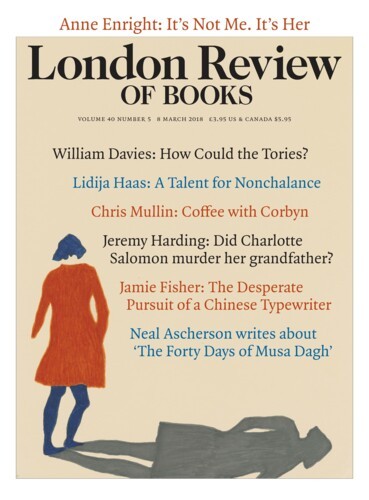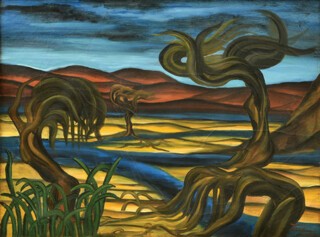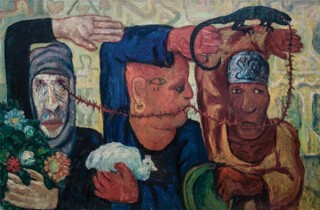Art et Liberté was a movement that came into being in 1938 in Cairo. It was affiliated to Surrealism through contact with André Breton in Paris, and shared Surrealism’s spirit of rebellion and provocation, its desire for dream knowledge and penchant for manifestos. ‘Long live degenerate art’ was the title of its opening blast, printed in Arabic and French alongside a reproduction of Picasso’s Guernica and signed by writers and artists from a great variety of backgrounds but united in their political leanings and belief in culture without borders. ‘We refuse to see in these reactionary myths anything other than concentration camps for thought,’ they declared. The signatories were springing to the defence of artists like Max Ernst who had been labelled degenerate by the Nazis, but they were also taking on enemies closer to home and resisting the rise of fascist sympathisers in Egypt. The Futurist Marinetti, who was born in Alexandria, visited Cairo in 1938 to whip up support for his idea of modernity: he had found a messiah in Mussolini and his arrival caused a storm.
The leading figure in the Cairo group of fighters for art and freedom was Georges Henein, a poet and pamphleteer. He was well-off and well-connected: his father, a Copt, was a banker and one-time director of the Refrigeration Company of Egypt (a key role!), as well as a close associate of King Fouad. His mother was of Italian descent, part of a large community which – along with Greeks, Armenians, French and various combinations of Jewishness and Arabness – made up the polyglot mix of the eastern Mediterranean and urban Egypt. Henein had been educated in Paris and spent part of his childhood in Rome, and the cry against fascism he raised in 1938 must be put in the context of conditions in Italy and the ambitions of Mussolini in Africa – his new Roman empire. Many of the Italians in Alexandria and Cairo had come because they read the signs: the writer Fausta Cialente, who was married to a Jewish composer, left her native Trieste in the 1920s. She joined a sizeable community of diasporic Italians opposed to the regime back home not only for reasons of ethnicity: Cialente would later broadcast from the partisan station Radio Cairo to Italian prisoners of war. Many were artisans – carpenters, tilers, painters. Others had come to work, as engineers and construction workers, on the Suez Canal. The poet Giuseppe Ungaretti, who like Marinetti was born in Alexandria, belonged to this milieu. But the new king, Farouk, was susceptible, it was feared, to the attractions of fascism, and was surrounded by Mussolini supporters. (There’s a story about the British ambassador Miles Lampson, who happened to be married to an Italian; he was notoriously high-handed, treating Farouk as a client king, once surrounding the palace with tanks to force his hand over a change of government. When he ordered Farouk to dismiss the Italians in his entourage the king replied: ‘When you get rid of yours.’)
The British were the supposed ‘protectors’ of the country, with very deep interests in holding onto their influence: not least on account of the Suez Canal, which they co-owned with the French. When North Africa became an important theatre of the war with Germany, Egypt in theory remained neutral, and Cairo became a magnet for soldiers on R&R – for such visitors, the city wasn’t suffering from shortages. At one time, there were around 140,000 British troops enjoying the cafés, dance halls, cinemas and shows. But the signs of tumult had started years before, when crowds of Blue Shirts, a local fascist youth group, marched in the streets of Cairo. The war in the desert took a heavy toll on civilians as well as soldiers. The German air force bombed Alexandria in 1938, and a pervasive dread of their coming victory took hold. It’s easy to forget what the war felt like before the victory of the Allies at El Alamein. In his Levant Journal the poet George Seferis, who was attached to the Greek government in exile in Cairo after Greece had capitulated, recalls grim scenes of panic and disorder as the British, fearing imminent defeat and a German invasion, evacuated thousands of civilians across the border to Palestine.
Art et Liberté’s visions of Dantesque torments, in desert landscapes broiling with lurid oranges and metallic blues, arose out of this time of destruction and terror. Inji Efflatoun was inspired by a poem by Henein, ‘A contre-cloison’, to paint a series called Girl and Monster. In one of these images, a pair of lovers have been killed in a bombing raid; contorted, blasted trees surround them, and their severed heads cleave together in the burning ground. Efflatoun was only 18 at the time, and you can see the passion in her brush; at first her heavy delineations look crude and her palette too blatant, but she was matching method to matter. Another of the women in the group, Amy Nimr, has a more delicate touch as, in gouache and ink, she conjures death and destruction in horrific studies of lacerated and flayed bodies: in 1943, when everything should have been all right, she went on a family picnic in the western desert; her child picked up a camouflaged bomb and was killed.
I hadn’t heard of any of the artists in the Art et Liberté exhibition, which for its stint at Tate Liverpool has been called Surrealism in Egypt (until 18 March). I hadn’t even heard that such a movement had existed until the exhibition opened in Paris last year, and the curators Sam Bardaouil and Till Fellrath published the catalogue, Art et Liberté: Rupture, War and Surrealism in Egypt (1938-48), followed by a monograph by Bardaouil, Surrealism in Egypt: Modernism and the Art and Liberty Group (I.B. Tauris, £24). Nor can I recall ever being so disoriented by unfamiliarity as I was when I first wandered through the show – not when I was young and first saw a portrait by Picasso or a drip painting by Pollock. These Egyptian artists’ paintings struck me as ugly, cartoonish: grotesquely mutilated and disembowelled bodies executed with huge emphatic brushstrokes, cruelly exposed women in twisted landscapes, strange and opaque symbols straining for meaningfulness. But then I realised that this first impression was simply an effect of alienation, a primitive, instinctual rejection on my part of the unfamiliar, and that it was this very jolt to complacency and atrophy and idées reçues that the artists wanted to deliver.
The show’s layout and selection make it clear that the movement should not be seen as hierarchical, with Paris as the metropole and all the other clusters of activity – in Mexico, Martinique, Argentina, Chile and Egypt – as marginal, effects of cultural cringe and colonialism. The structure, as Bardaouil explains, was rather ‘a multi-latticed network of fluid hubs spread over a disparate number of cities across the world’; individuals moved between them, transmitting ideas as they went, like honey bees. Lee Miller married an Egyptian and lived in Cairo during the war; she found fresh inspiration in the desert for experiments with form and perspective and connected the scene in Cairo with Roland Penrose, the champion of British Surrealists (some letters to him, not always polite about her Cairo friends, are included in the show – she was having a love affair with him and they would later marry). The movement was global in one sense, but the artists also vividly communicate their local circumstances; they incorporate Egyptian landscape and monuments, popular rites, folklore and history. The painter Kamel El-Telmisamy vigorously claimed that Egypt was intrinsically surrealist and needed no instruction from elsewhere: ‘The word … is nothing but the modern technical term to what we have always referred to as free imagination.’ Certainly the vast desert landscapes that stand in for the scenery of the unconscious in so many Surrealist works (think of Salvador Dalí) have concrete reality for Egyptians. Early on, in 1928, Amy Nimr adapted the Ancient Egyptian tomb paintings’ vision of demons fishing for souls in Untitled (Girl with Fishnet), showing a contemporary naked figure landed on a beach. Another member of the group, the best-known today, Ramses Younane, transformed Egyptian motifs in his responses to his country’s struggles for autonomy: a magnificent, untitled painting of 1939 takes the ancient figure of the sky goddess Nut, whose body arches over the world, and reimagines her as an emaciated corpse, spreadeagled on wreckage in the desert, with figures trudging towards a horizon of seemingly limitless waste. Here the language of Henry Moore’s truncated nudes reverberates with visions of ruined, pharaonic colossi.
Henein and his fellow rebels were utopian dreamers, and sexual freedom too was part of their vision. The Egyptian movement shares Surrealism’s obsession with women and desire to defy bourgeois convention and decorum. Breton, setting out to define ‘la femme’ for his short dictionary of Surrealism, quoted Baudelaire: ‘La femme est l’être qui projette la plus grande ombre ou la plus grande lumière dans nos rêves’ (‘Woman is the being who brings the greatest shadow or the greatest light into our dreams’). The exhibition is arranged to draw attention to this: the third room, ‘The Woman of the City’, displays many studies of prostitutes, again inspired by a poem of Henein’s, ‘St Louis Blues’. Although the same model posed for several of Fouad Kamel’s sombre and searching portraits, they are not primarily records of a living individual so much as elegiac emblems: while her gaunt features, her dejected, drooping head and profoundly melancholy expression speak of poverty and misery, the green seedlings in a small pot in her hands seem to promise hope.
The wall label, however, sees the plant as another sign of addiction and the drug’s grip on this underclass. This is an instance of a certain embarrassment that hovers over parts of the show, and arises from current, changed attitudes to the oneiric powers of Woman, and growing unease about sexual imagery in general. In the same room, a blazing and eerie portrait called La Femme aux boucles d’or looks out at us, her tigerish lambent eyes matching her hair and a keen amused expression curving her full lips; behind her are the banks of the Nile. Bold, unveiled, self-possessed, aglow with inner force, rather eerie, she does indeed seem to be projecting the greatest light into this artist’s dreams. It turns out that he was Mahmoud Saïd, the son of a former prime minister and the uncle of Queen Farida, wife of Farouk; he had been trained as a lawyer but gave up the bar for art; and his subject seems to embody an idea of modern Egypt.
After the war, Art et Liberté’s cosmopolitanism came increasingly into conflict with the rise of nationalism, and Arab nationalism at that: the call was for optimism and praise-singing and the group splintered into smaller groups, rallying around various banners such as ‘Subjective Realism’ and ‘New Orientals’. In 1945, sickened by Hiroshima, Henein wrote a blazing pamphlet, The Prestige of Terror, denouncing the use of the atomic bomb: ‘Ces pratiques perfectionnées, ces suprêmes raffinements dans le meurtre, n’avaient rien qui put rehausser la cause de la liberté, le parti de l’homme’ (‘These perfected technologies, these supreme refinements of murder, have done nothing to bolster the cause of liberty, the cause of humanity’). He found himself at odds, too, with Egypt, especially after Nasser came to power in the revolution of 1952. Former enfants terribles, left-leaning scourges of convention and hypocrisy, found that the new regime saw them as decadent, revanchist cosmopolitans, spiritual and political detractors of the proud new future, not properly and loyally Egyptian. For one thing, the group included many members who had been educated abroad; for another, Henein wrote in French, and Francophonie was increasingly frowned on. Henein dissociated himself from the group he had founded as members tried to meet the regime’s prescriptions. He left Cairo in 1962; many of his friends and associates spent some time in prison before they too scattered. The political changes, local and international, overcame the Egyptian Surrealists’ dreams of global fellowship and exchange as the foundation of modernity.
Bardaouil argues that Edward Said’s Orientalism sets up too rigid a polarity between East and West, and that his views have inadvertently contributed to nationalist isolation; he respects Said and his book’s historic importance but points out that Art et Liberté set out to reorientate relations between Orient and Occident, and the movement’s activities necessitate a realignment of our perspective. Its members belonged to a global republic of ideas and were forming their own future and fellowship, ideas flying back and forth between them, crossing borders, cross-fertilising through magazines, posters, pamphlets and books (the vitrines in the show don’t do justice to this profusion of work: the examples are hard to see, and aren’t given enough context or transcriptions).
This is a path-breaking show, the fruit of deep archival exploration, and the books that accompany it light the Farouk years from a surprising angle. The exhibition gives the colonial, wartime period and its aftermath the feel of an Egyptian Weimar, and casts its artists as Cassandras who saw but weren’t heard. The paintings, photographs and ephemera reveal the resonance the movement’s hopes have for culture and politics today, in the aftermath of the Arab Spring, when ethnic and religious labelling and boundary demarcations are again so dangerous and divisive.
Send Letters To:
The Editor
London Review of Books,
28 Little Russell Street
London, WC1A 2HN
letters@lrb.co.uk
Please include name, address, and a telephone number.



